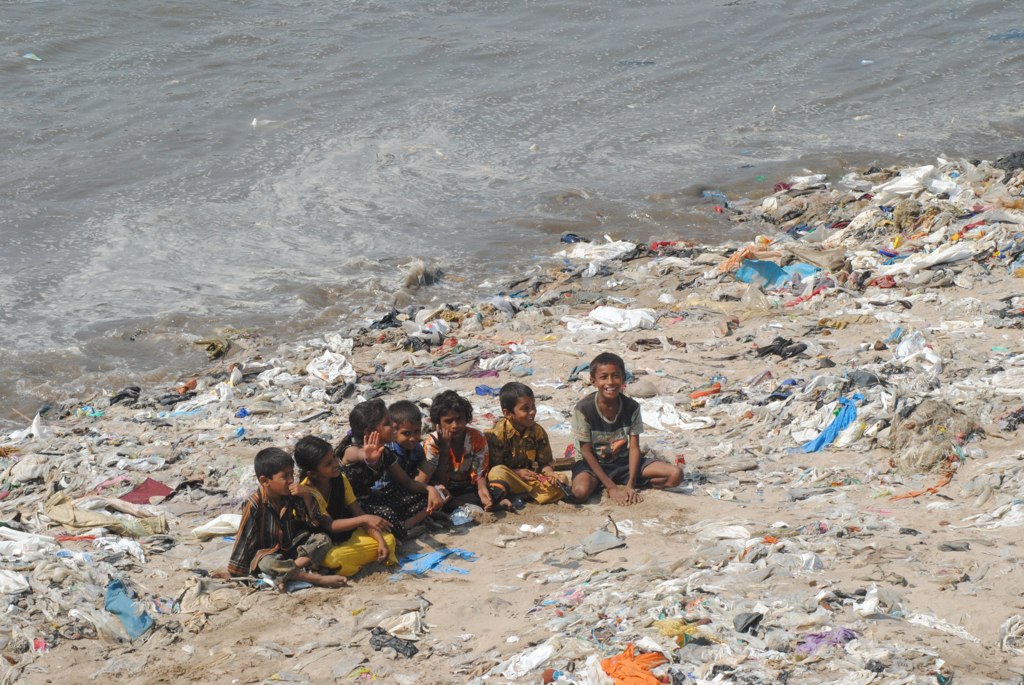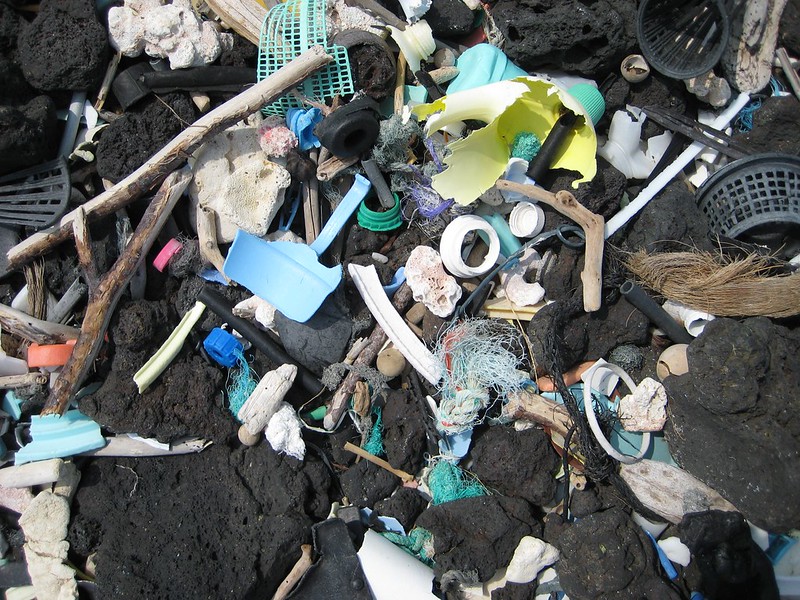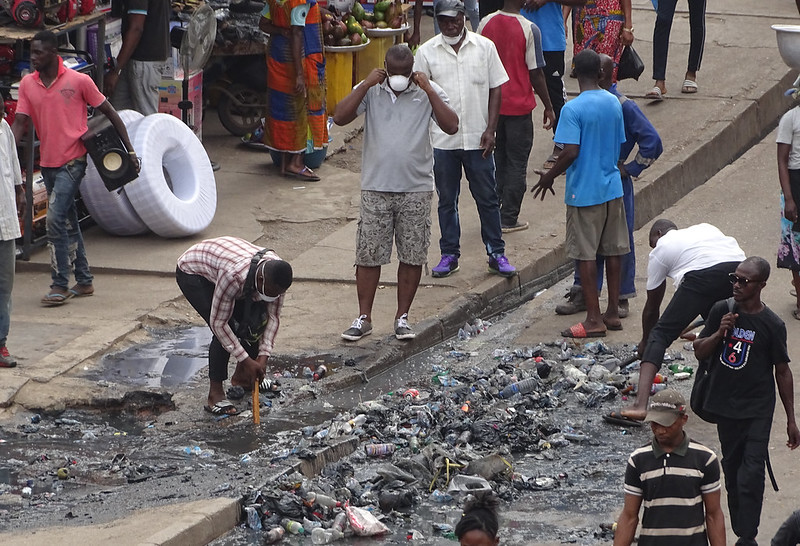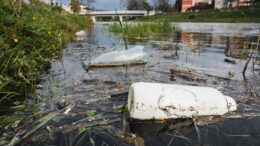In 2016 I sailed with scientists across an oceanic vortex filled with plastic and other human detritus swirling between the coasts of Hawai‘i and California to see the Great Pacific Garbage Patch. While the word patch seems to confer a floating island of trash, the reality is far more dire: A shocking amount of consumer waste has traveled to a place distant from any kind of human settlement, creating a dense, uncontainable soup of all manner of plastic stuff, from household objects to fishing gear — and the infinite number of small chemical-laced particles all plastics constantly shed.
As representatives of United Nations member states prepare to meet Feb. 28-March 2 at the fifth Environment Assembly in Nairobi, Kenya, addressing plastic pollution in the seas is a top priority. But they must recognize that, like the illusion of the “Garbage Patch,” our present plastic predicament is far more catastrophic than most people are aware — and it continues to worsen.
Tiny toxic plastic particles now permeate not only the oceans, but indoor and outdoor air, freshwaters, soils, plants, outer space, and the bodies of humans and other animals. UN negotiators must take urgent steps to recognize plastic pollution as more than a matter of litter in the ocean, as it has historically — and misleadingly — been portrayed. It’s now time to develop a binding, enforceable agreement that would require the plastics industry and other entities that have supported its rapid rise be held accountable for the damages caused to people and the planet, and lay out a pathway to a safe, equitable future without plastics.

In the long span of human history, plastic is a relatively new invention, only rolled out for mass production in the mid-1900s. By 1960, when widespread use of plastic was not yet ubiquitous globally, plastics made up less than 1% of household trash by weight in middle- and high-income countries. Today plastics make up at least 10% of the same countries’ household waste. In less than 80 years, industries have churned out more than 8.3 billion metric tons of various kinds of petrochemical-based plastics, most of which has been discarded or entered nature and will never benignly biodegrade.

Just 9% of thrown-away plastic is recycled, mainly because industry doesn’t design most plastics to be recycled. It’s much cheaper to throw it away, and governments and waste-hauling industries make fortunes off others’ misfortunes.
All the plastic we use will never disappear. Instead it is shipped, landfilled, incinerated, open-burned or dumped in someone else’s backyard to release noxious odors, plastic particles, dangerous toxins, diseases and climate-warming greenhouse gases.
All along the plastics production, transportation and disposal pipeline, it’s predominantly communities of color and lower-income people who are harmed by pollution, industrial emissions, plastics’ toxic chemicals and industrial accidents. For these reasons, plastics were finally recognized last year by the UN as an urgent human-rights problem, though frontline communities have been fighting continued fossil fuel, chemical and plastics development for many decades. Our world is presently set up to allow plastics’ producers to benefit from a kind of industrialized systemic racism as toxic and insidious as plastic itself.

But plastic’s toxic reach harms us all. Plastic is made with any combination of thousands of chemicals known to harm humans — including hormone-disrupting PFAS, phthalates and BPA. Plastic particles and the chemicals they carry are accumulating in plants, animals and ecosystems, our bodies and bloodstreams alike, and are even passed down through generations. Recent research suggests mothers pass plastic particles into their babies’ bodies through the placenta. People appear to eat, drink and breathe in plastic pieces. One researcher, Sherri Mason, described them to me once as “little poison pills.”
Plastics and their particles — and the hundreds of thousands of other synthetic chemicals humans have created — have become so widespread across the planet in the past century that scientists recently published a peer-reviewed scientific paper warning there’s more entering nature than any entity can reliably assess or control. This puts the long-term survival of all life at risk. The scientists urged swift action be taken to curb the rising tide of chemicals and plastic, though they also acknowledged that the plastic and chemicals already out there will continue to pose risks well into the future.

Those risks must be immediately mitigated, especially for communities of color worst harmed by plastics’ environmental injustices.
The core part of the answer to our plastic problem is to stop making more of it and require industries to address the mess they’ve made. We need a treaty that would hold international industries and governments accountable for ceasing plastic production. The Basel, Rotterdam and Stockholm Conventions are designed to protect human and environmental health from dangerous chemicals and wastes during production, transportation, use and disposal. These binding existing frameworks for regulating hazardous substances could be broadened and strengthened to include plastic and its petrochemical based ingredients and additives.
The Stockholm Convention is specifically designed to restrict or stop production of long-lasting “persistent” substances known to cause serious harm to humans, wildlife and ecosystems. Given this criteria, plastics would also qualify.
We also need to make sure our world works in a manner that minimizes waste and maximizes human and environmental health, in ways that are just and equitable to people and nature. UK economist Kate Raworth has proposed a donut-shaped economic model under which humanity would focus not on the usual measure of GDP but on “meeting the human rights of every person within the means of our life-giving planet.” The UN should lay out a pathway for replacing our current industrially driven exponential-growth society with restorative and regenerative local systems. Societal values that minimize waste — like sharing, reuse and repair — could be fostered through regulations, education, incentives and other behavior-changing strategies.

The biggest opponents of efforts to tightly regulate plastics, petrochemical and fossil fuel production are the industries perpetuating the problem. Industry misinformation continues to portray plastic as an important lightweight material for the “low-carbon” future that’s now necessary on our warming planet. But just as it has been doing all along, the industry is continuing to try to delay the necessary action of turning off the plastics tap once and for all. The plastic industry is on track to churn out more plastic than ever before and will only accelerate production unless we demand global negotiators take serious action to hold industries accountable now.
Ironically, in a world hyperconnected by plastics, the dire truths about this material have rapidly spread. Today, support for a global treaty on plastics has never been greater and more diverse. A significant and growing coalition — spanning businesses, communities, nonprofits, leading scientists, and many others — have recently called for an international agreement on plastics. Now such a treaty is a near-future possibility. We must ensure one is created — and that it doesn’t get watered down by industry interests as so many other plastic regulations have.
It’s critically important to use this present opportunity to officially identify the true causes of plastic pollution — industries’ continued production of plastics, petrochemical and fossil fuels. Instead of continuing to burden consumers with the tasks of cleaning up and fruitlessly recycling, as we always have, it’s time to stop plastics production at the source and change the systems that have supported its rise.
The opinions expressed above are those of the author and do not necessarily reflect those of The Revelator, the Center for Biological Diversity or its employees.
Previously in The Revelator:
4 Major Environmental Treaties the U.S. Never Ratified — But Should


